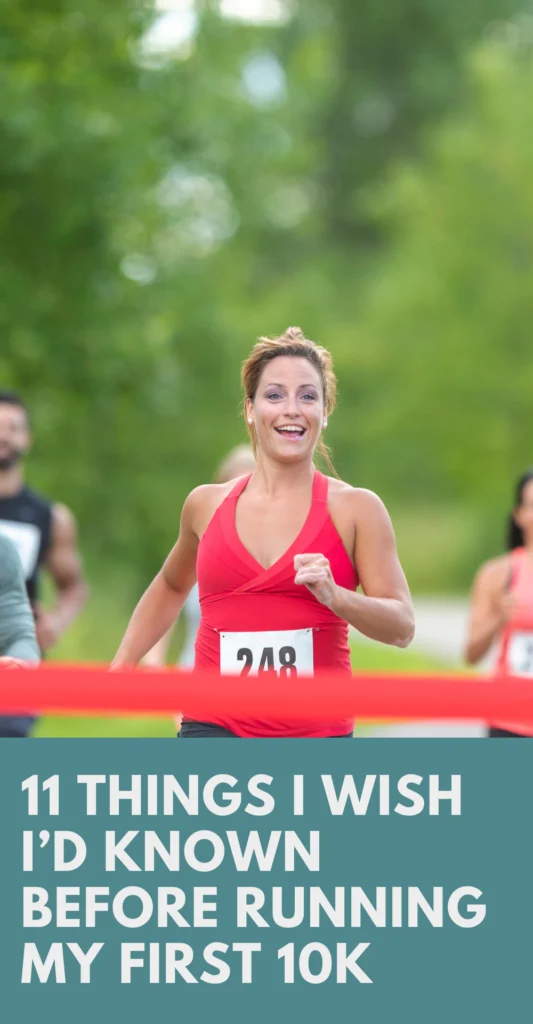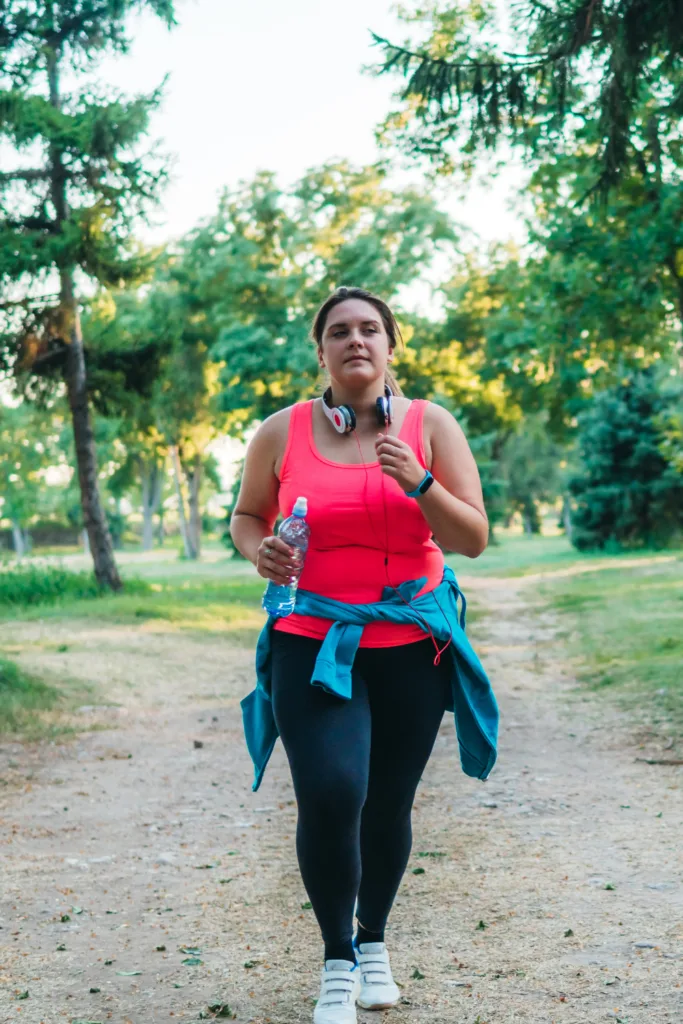Running a 10k is a rite of passage for many runners.
If you’re planning to run your first 10k, then this guide on first 10k tips has got you covered!
Why is the 10k so popular?
The 10k is long enough to push you out of your comfort zone, yet short enough to be a realistic goal for many beginner runners.
It is for this reason, many beginner runners go on to complete a 10k having run their first 5k following a programme like Couch to 5k.
But what do you need to know before running your first 10k?
This guide we’ll provide you with everything you need to know!
We’ll look at:
- How long is a 10k?
- How to train for your first 10k
- How to prepare for your first 10k
- First 10k Q&A
- 11 things I wish I’d known before running my first 10k
Ready
Let’s go!

How long is a 10k?
A 10k in miles is 6.1 miles.
The 10k makes up over 14% of all running events and 7% of all finishers in 2017 in the USA.
It often represents a stepping stone from the 5k (3.1 miles) to longer distances such as the half marathon (13.1 miles).
Related: How many miles is a 10k? Average 10k times by age and gender
How to train for your first 10k
When training for your first 10k, preparation is key.
This boils down to a good 10k training plan that is suitable for your fitness levels and running experience.
If you’re running your first ever 10k, then it’s recommended you start with a beginner 10k training plan.
A beginner 10k training plan will last anywhere between 6 to 10 weeks and will typically include the following runs and workouts:
- 1-2 easy runs
- 2 cross training sessions (e.g. walking, swimming, cycling)
- 1-2 strength training session (optional)
- 1 long run
- 2 rest days
#1 Easy runs
Easy runs are designed to be just that – ‘easy’.
Don’t worry about speed or pace during these runs, as long as you cover the required distance and run at a gentle pace.
You should be able to comfortably hold a conversation when you run.
In this plan you will have three easy runs per week.
#2 Long runs
You typically have one long run per week, either on a Saturday or Sunday, so you can plan it into your weekend.
Long runs should be run at a slow pace – and don’t be afraid to take walking breaks.
Your goal is to cover the distance and not be exhausted after a few miles.
The longest run in a beginner 10k training plan typically ranges from 5 to 7 miles.
#3 Cross training
Cross training is basically any activity other than running that is classified as aerobic training.
Walking, brisk walking, hiking, cycling, Pilates and yoga and swimming are all good forms of cross training.
Cross training is great for runners because it conditions different muscle groups, allows you to develop new skills and adds variety into a training plan.
It also allows you to vary the intensity of your workouts.
#4 Strength training
Strength training is essential for any runner as it has the potential to improve your running performance, reduce the risk of injury and benefit your running form and economy.
The injury rate in the running community remains pretty high – so there is even more reason to dabble in a bit of strength training.
Bodyweight exercises and free weight exercises are typically included in a strength training session.
You’ll want to focus on all body movements and unilateral movements in your training as these are the types of movement used in running.
Exercises that strengthen your core are also recommended for runners.
Check out my strength training guide for runners for more information on including strength training in your training routine.
#5 Rest days
Rest and recovery is integral to any training plan and is a crucial part of a good injury prevention strategy.
Many runners think rest days are wasted time, when in fact you can’t train efficiently without proper rest and recovery so take them seriously.
Your main rest days should be before and after your long run – so before and after the weekend.
#6 Stretching and foam rolling
Stretching and foam rolling are crucial in the recovery process and helps to reduce muscle soreness and improve flexibility.
Make sure you find time to stretch and foam roll, particularly after long runs!
Related: The ultimate beginner 10k training plan: Week by week plan + printable

How to prepare for your first 10k
Preparation is key when preparing for your first 10k in the weeks and days leading up to your 10k race.
#1 Remember to warm up
On the day of your 10k race you’ll want to do a warm up.
A warm up is designed to get your heart rate up before your run and warm up your muscles.
Before your run, your body will be in a fairly restful state.
Your blood oxygen levels will be low, making it difficult to fuel the high level of activity needed for your race.
By doing a warm up, your body will start to ramp up its oxygen levels needed to perform at a high level during your run.
It often takes 10 minutes or so for your oxygen levels to ramp up, so even more reason to do a warm up to ensure your body is ready to go at the start of your run.
Aim to include a light jog and some pre-run stretches in your warm up.
You may also want to include some strides if you feel comfortable.
#2 Wear the right running shoes
You’ll want to wear a pair of running shoes that you trust and feel comfortable wearing on the day of your 10k race.
You do not want to be wearing a brand new pair of running shoes on race day.
Wearing the right pair of running shoes throughout your training and on race day will help to improve your running performance and help prevent injuries.
Check out my running shoes guide for more information on finding the right pair of running shoes.
#3 Eat the right foods
Food and nutrition are just as important as running itself when it comes to training for a 10k.
Your body will burn through a lot of energy throughout your training and on race day, so fuel it properly.
Aim to eat a healthy, balanced diet and stay hydrated.
Your two main fuel sources should be carbohydrates and protein, with the right amount of fruit and vegeatables.
Check out my guide on what to eat before a run for more information and tips.
#4 Listen to your body
Training for your first 10k can be gruelling, especially if you’ve only ever ran 5k runs.
You’re effectively doubling the distance that you’ll be running.
Throughout your training, and indeed on race day, it’s important you listen to your body.
An injury often starts as a whisper – it’s important you listen to those cues in order to know when to stop and when to dial your training back.
Rest days are scheduled in a training plan for precisely this reason so you are not overdoing it, so don’t be tempted to skip them.
#5 Pace yourself
You may already have a goal race time in mind.
Whatever this is, make sure it is realistic according to your running experience and fitness levels.
If you’re a beginner runner, you can expect to run a 10k in between 60 and 70 minutes.
The average 10k time is 49:43 across all ages and genders, so if you finish your 10k at around 50 minutes, this is a huge achievement!
You can use a running pace calculator to work out what your pace should be during your training and on race day.
The key is to stick to this pace throughout your training, and adapt your pace for different training runs.
#6 Be consistent
A successful training plan comes down to consistency.
In order to achieve your goal race time, you will need to put in the miles each week and maintain momentum throughout your training.
It may feel daunting at first, but with the right mindset and motivation, you will get there!
Related: What is a good 10k time? Average 10k times by age and gender

First 10k Q&A
Q: What is a good 10k time?
A: The average time for a 10k depends on a number of factors, including your age, gender and fitness levels.
Your injury history and the race course terrain can also determine your 10k average time.
Beginner runners typically finish a 10k in between 50 to 70 minutes.
If you cross the finish line in under 70 minutes, then this is a huge achievement.
Q: What should my 10k pace be?
A: Your pace (i.e. how quickly you a run a certain distance) will depend on a number of factors, including your age, gender and fitness levels.
If you want to run your first 10k in under 60 minutes, for example, then you will need to run at a pace of at least 9:39 minutes per mile / 6 minutes per kilometre.
You can read more in my guide about average 10k times.
Related: How to run a 10k in 45 minutes or less

First 10k tips: 11 things I wish I’d known before running my first 10k
Now you know more about training for your first 10k, here are 11 things I wish I’d known before running my first 10k.
#1 Slow down
When I ran my first 10k, I learned that it is much more about endurance compared with the 5k.
I also quickly learned that I couldn’t sustain my 5k pace for the duration of the race as I’d just end up in a heap on the floor by mile 4.
Your 10k race pace will typically be 10-30 seconds slower than your 5k race pace.
Slow down and apply what you have been practicing during your training.
To get a better feel, you should aim for about 80-85% of your maximum effort.
This essentially means running at a pace that feels ‘comfortably uncomfortable’.
Your breathing may feel laboured, but you still have enough energy to finish the race.
#2 Play to your strengths
Don’t be afraid to play to your strengths as a runner during a 10k.
Some runners prefer to chunk up the race and have a conservative and controlled first third, then run at a faster effort during the last two thirds.
If you feel comfortable setting the tempo from the very beginning, then figure out your desired race pace and stick with this and finish strong.
Whereas if you prefer to ease into the run and start and finish in a comfortable, controlled manner, then this is equally fine too!
I much prefer to hold a comfortable, controlled pace for the first two thirds of the race, then run slightly faster for the last third.
#3 Be mentally prepared
Your brain likes to play mind games when you’re on a run.
The urge to quit is real!
These feelings are completely normal – but the best runners know how to leverage these feelings and dig deep in order to cross the finish line.
Just think about how far you’ve come!
Another way to think about it is that the race you’re about to do is just 5k runs back to back.
This way it will become much more manageable mentally.
#4 Don’t compare yourself to others
Every runner loves to compare themselves to other runners who are slimmer, leaner, faster, have better running shoes – whatever the reason!
I used to do this all the time and it took a lot for me to learn to ignore other runners and just focus on my own running journey.
I’ve learned that comparing yourself to other runners does nothing but erode your confidence.
So ignore the negative self talk and focus on your own race!
#5 Download a 5k to 10k app
A 5k to 10k app is a great tool to use in your training, especially if you’d like to work your way up from running a 5k to a 10k.
Some apps offer ‘done for you’ training plans based on your running experience, training needs and desired race time.
These are great if you want to take the confusion out of training and have a ready-made training plan that you can easily follow.
Check out my guide on the best 5k to 10k running apps for more information.

#6 Join a running club
Joining a running club can do wonders for your confidence, accountability and motivation.
Some of the best running clubs combine running with social gatherings, like a post-run pint or even environmental credentials like plogging.
There are tonnes of fantastic running clubs and groups nowadays that you can join.
Just be sure to join one that matches your running experience and goals.
And I’m sure many runners in these groups will be able to share their running wisdom.
Check out my guide on running clubs for more tips and advice on finding the best running group for you.
#7 Try running solo
If you’re used to running in a group, then I’d recommend you try running solo at least once or twice a week in the lead up to your 10k race.
This will force you to rely on yourself for motivation and will make you a stronger runner.
I personally loved taking myself off for a run at the weekend, especially when the weather was good.
There’s nothing better than getting up early for a run – the sense of satisfaction afterwards is amazing!
Of course, with any solo run, keep safe and always tell someone where you’ll be going.
Plan your running route ahead of time and ensure it’s safe and well-lit if you’re running at night.
#8 Prioritise nutrition and hydration
Over the years I’ve learned A LOT about nutrition and hydration and how important they are for optimal running performance.
As the old saying goes, carbs are a runner’s best friend, but it is equally as important to ensure you eat a varied, healthy and balanced diet.
This includes the right amount of carbs, protein, healthy fats as well as essential vitamins and minerals.
Many runners turn to supplements when they can’t get what they need from food sources.
Check out my guide on the best supplements for runners to learn more about how you can use supplements in your training.
#9 Make time for recovery
You’ll be pushing your body to its limits on race day, so factor in plenty of recovery time immediately after your run and in the days after.
Don’t be tempted to jump straight back into training – your body won’t be ready and you’ll heighten the risk of injury.
Of course, only you will know when you’re ready to return to running, but leave it at least 2 days before going for a run.
I certainly needed a break after my 10k race and I enjoyed having some downtime before I got back on the wagon again.
#10 Perfect your running form
Now you’re started to dabble in longer distances like the 10k, it’s time to take your running form seriously!
Proper running form is all about running in the most efficient way possible so the least amount of stress is put on your muscles and joints.
Running is a high impact sport and if you run regularly, this can cause damage to your muscles, joints, tendons and ligaments if you don’t run properly.
When I first started out running I later discovered I had the tendency to overstride.
This meant my heel hit the ground first when I ran, meaning more stress and pressure was put on the muscles and joints in my ankle and leg.
So I wondered why I kept getting injured, when in fact my running form and technique was out of whack!
When I finally learned the best way to run, my performance improved and my race times got quicker.
Although there isn’t one perfect way to run, there are simple principles that you can follow.
If you want to learn more, read my guide on proper running form and technique.
#11 Celebrate the wins
When training for a race like a 10k, it’s all too easy to focus on what you’re doing wrong or what you need to improve.
Whilst it’s human nature to focus on your flaws and faults, it helps to celebrate the small wins sometimes!
I like to do this by rewarding myself and looking at how far I’ve come.
Tracking progress is a great way to do this, so make sure you keep a record of all your training runs and see where you have made improvements.
Related: 51 inspiring keep pushing quotes to keep you motivated
- 5 things I wish I’d known before returning to running - March 3, 2024
- Running 20 minutes a day: Benefits + how to start - January 27, 2024
- How to run your first 2 hour half marathon - January 16, 2024
